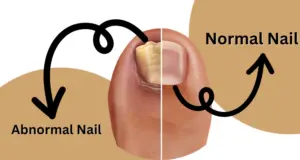Introduction – Encyclopedia of Nail Abnormalities
Our nails serve not only as a canvas for creativity and self-expression but also as indicators of our overall health. Nail abnormalities can present in various forms, colors, and patterns, often signifying underlying conditions or deficiencies. In this visual encyclopedia, we will delve into the world of nail abnormalities, exploring their causes, symptoms, and real-life examples. By understanding these conditions, you can identify potential concerns and seek appropriate care to maintain both the aesthetics and health of your nails.
Understanding Nail Abnormalities
1.Discoloration:
- Yellow Nails: Often associated with fungal infections, yellow nails can also indicate respiratory conditions or even psoriasis.
- White Spots: These small, white spots or dots can result from minor injuries, nutrient deficiencies, or certain allergies.
- Blue Nails: Blue nails can be a sign of poor circulation, lack of oxygen, or underlying medical conditions like Raynaud’s disease.
- Dark Lines: Dark lines or stripes on the nails may indicate melanoma or other forms of skin cancer, requiring immediate medical attention.
2.Texture and Surface Irregularities:
- Ridges: Vertical ridges are a common occurrence with age, but deep horizontal ridges can indicate nutritional deficiencies, trauma, or illness.
- Pitting: Small depressions or pits on the nail surface may be associated with psoriasis, eczema, or autoimmune conditions.
- Beau’s Lines: These transverse depressions across the nail plate can appear after severe illness, indicating a pause in nail growth.
3.Shape and Structure Abnormalities:
- Clubbing: Enlargement of fingertips and a curved nail bed can be a sign of respiratory or cardiovascular diseases.
- Spoon Nails: Also known as koilonychia, spoon-shaped nails can signify iron deficiency anemia or hemochromatosis.
- Splitting and Brittle Nails: Dryness, frequent exposure to water, and certain medical conditions can lead to brittle, splitting nails.
4. Spoon Nails
- Iron Deficiency: One of the most common causes of spoon nails is iron deficiency anemia. A lack of sufficient iron in the body can lead to changes in the nail structure.
- Hemochromatosis: This is a genetic condition where the body absorbs too much iron from food, leading to iron overload. It can result in various health issues, including spoon nails.
- Trauma: Repeated trauma to the nail matrix, such as from excessive use of nail tools, can cause the nails to change shape over time.
5. Nail Pitting
- Psoriasis: Nail pitting is a common feature of psoriasis, an autoimmune skin condition that causes red, scaly patches on the skin. It can also affect the nails, leading to various changes, including pitting.
- Alopecia Areata: This autoimmune condition primarily affects hair follicles, leading to hair loss. However, it can also result in nail changes, including pitting.
- Eczema: Eczema, also known as atopic dermatitis, can cause inflammation and changes in the nails, including pitting.
6. Psoriasis
- Pitting: One of the common nail changes seen in psoriasis is nail pitting. Pitting refers to the presence of small, shallow depressions or indentations on the nail’s surface. These pits can vary in number and size and are often seen on multiple nails.
- Onycholysis: Onycholysis is the separation of the nail plate from the underlying nail bed. In psoriasis, this can cause the nails to become loose and eventually detach from the nail bed.
- Oil Spots: Small, reddish-brown spots that resemble drops of oil under the nail plate are known as oil spots. They are a characteristic feature of psoriatic nail dystrophy.
Real-Life Examples and Symptoms
- Onychomycosis (Nail Fungus):
- Symptoms: Thickened nails, yellow or white discoloration, crumbling or brittleness, distorted nail shape.
- Real-Life Example: Insert relevant example or case study.
- Psoriasis:
- Symptoms: Pitting, discoloration, thickened nails, ridges.
- Real-Life Example: Insert relevant example or case study.
- Paronychia:
- Symptoms: Redness, swelling, pain, pus formation around the nails.
- Real-Life Example: Insert relevant example or case study.
- Causes and Treatment Options
- Understanding the underlying causes of nail abnormalities is crucial for appropriate treatment. For a precise diagnosis and a customised treatment plan, consult a healthcare expert. Some common causes and treatment options include:
- Fungal Infections:
- Causes: Fungi entering through cracks or cuts in the nails, warm and moist environments.
- Treatment: Antifungal medications (topical or oral), keeping the nails clean and dry, avoiding nail polish during treatment.
- Nutritional Deficiencies:
- Causes: Inadequate intake of essential nutrients like biotin, iron, zinc, or vitamins.
- Treatment: A balanced diet, supplements, incorporating nutrient-rich foods, and addressing underlying deficiencies.
- Trauma or Injury:
- Causes: Accidental trauma, excessive use of harsh chemicals ,repetitive stress.
- Treatment: Protecting nails from further damage, proper nail care ,avoiding excessive exposure to chemicals ,allowing time for nail regrowth.
- Underlying Medical Conditions:
- Causes: Various systemic conditions ,such as psoriasis, eczema, anemia, or cardiovascular diseases.
- Treatment: Managing the underlying condition, medications, lifestyle changes, and targeted therapies.
FAQs
Q1. Are nail abnormalities contagious?
A1. In most cases, nail abnormalities are not contagious. However, certain fungal infections can spread from one nail to another or from person to person. It’s important to practice good hygiene and avoid sharing personal items like nail clippers or files to minimize the risk of spreading infections.
Q2. Can nail abnormalities be hereditary?
A2. Some nail abnormalities can have a genetic component. Conditions like pachyonychia congenita or nail-patella syndrome are inherited and can result in abnormal nail growth or structure. If you have a family history of nail abnormalities, it’s advisable to discuss it with a healthcare professional.
Q3. Can I wear nail polish with nail abnormalities?
A3. It’s generally recommended to avoid using nail polish or other nail products while dealing with nail abnormalities. These products can trap moisture and hinder the healing process. However, if you choose to wear nail polish, opt for breathable and hypoallergenic options to minimize any potential damage or exacerbation of the condition.
Q4 – Will my Nails return to Normal after treating the underlying Cause of the Abnormality?
A4. In many cases, addressing the underlying cause of the nail abnormality can lead to the Restoration of normal nail growth and appearance. However ,the time it takes for nails to fully recover can vary depending on the severity of the Condition and Individual factors. Patience and consistent care are essential during the healing process.
Q5- Can stress contribute to nail abnormalities?
A5. Yes, prolonged or chronic stress can impact nail health and contribute to nail abnormalities. Stress can disrupt the normal growth cycle of nails, leading to changes in texture, shape, or growth patterns. Incorporating stress-management techniques into your routine, such as exercise, relaxation exercises, or therapy, may help improve overall nail health.
Q6- Are there any home Remedies for treating nail abnormalities?
A6. While home remedies may provide temporary relief ,it’s Important to address the underlying cause of the nail Abnormality. Consulting a Healthcare Professional is Recommended for appropriate Diagnosis and treatment options.
Conclusion
Nail abnormalities are not just about aesthetics; they can serve as important indicators of our overall health. By exploring this visual encyclopedia, you have gained valuable insights into the causes, symptoms, and real-life examples of nail abnormalities. Remember to consult a healthcare professional for an accurate diagnosis and personalized treatment plan if you notice

